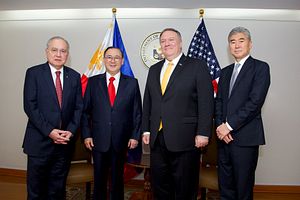On Tuesday, the administration of Philippine President Rodrigo Duterte said it had formally delivered a notice to terminate the Visiting Forces Agreement (VFA) to the United States, thereby deepening the uncertainty about the implications for the U.S.-Philippine alliance. While events are still playing out and this is only one part of the wider relationship between the two countries – which includes not only security but also economic and people-to-people links – it is worth delving into what the actual significance of the ending of the VFA would be for the alliance, the United States and the Philippines respectively, and for the wider region.
As I have noted before in these pages, the U.S.-Philippines alliance, which was born through the Mutual Defense Treaty in 1951, is based on a deep and wide-ranging partnership between the two countries and has been no stranger to round of stress-testing including in the defense realm – be it the renegotiation of base agreement terms in the 1970s or the closure of U.S. military facilities in the early 1990s. Indeed, it is worth recalling that the VFA is itself a product of a period of uncertainty for the alliance in the 1990s: the agreement, which was ratified in May 1999 and governs the terms under which U.S. military personnel can be temporarily present in the Philippines, was reached following an increased threat perceived by the Philippines from China in the early to mid-1990s after the U.S. base closures that had occurred.
While we have heard a series of threats from Duterte since he took office, the Duterte administration’s notice of termination with respect to the VFA constitutes the biggest actual threat to the U.S.-Philippine alliance since the president took office. To be sure, even though the clock in the 180-day period has begun, there are still steps that need to be taken to finalize the move, and since the broader alliance itself would still remain, there is the potential for the two sides to renegotiate terms for another VFA-type agreement further down the line. Nonetheless, it is worth contextualizing the potential significance of the move itself if it does indeed occur.
Bilaterally, terminating the VFA would effectively take the U.S.-Philippines alliance back to the early 1990s, when the alliance itself still remained but was neutered by a lack of U.S. military presence in order to facilitate the sort of collaboration, interoperability, and capacity-building that forms a core part of alliance collaboration. Without an agreement in place on a set of terms by which U.S. troops can be present on Philippine soil, there is a risk that we could see some discussion and potential reconsideration of the level and type of presence there that has helped undergird U.S.-Philippine defense cooperation, which has actually been improving by some measures despite Duterte’s threats. U.S. and Philippine officials have themselves spoken about the importance of some sort of VFA-like mechanism to both serve as a foundation for cooperation which could otherwise be lost as well as to enable U.S. security presence.
The VFA’s termination also creates complexities for both the United States and the Philippines respectively. For Washington, while alliance management has never been an easy affair, this would constitute the biggest blow to any of its treaty alliance relationships in Asia since the end of the Cold War, at precisely the time when the United States is trying to refocus itself on geopolitical competition with major powers, principally China and Russia. For Manila, this would degrade a significant source of security that it has continued to rely on even as its military capabilities remain limited and the threat posed by China remains real in spite of Duterte’s much-ballyhooed charm offensive to Beijing.
For the Asia-Pacific more generally, this will only increase uncertainty about the regional balance of power amid the intensification of U.S.-China competition. To be sure, the Philippines is a single country, and the U.S.-Philippine alliance may not rank as highly in terms of policy prioritization relative to Washington’s alliances with Japan or South Korea. But perception-wise, much like the closure of U.S. Philippine bases at the end of the Cold War, the fact the United States is being dealt such a blow by its own treaty ally – with potential follow-on implications for aspects such as its overall military presence in the Asia-Pacific – will only further intensify doubts that exist today about U.S. policy initiatives such as the Free and Open Indo-Pacific vision and the extent of alignment on regional issues between Washington and its allies and partners. And given China’s previous record of capitalizing on the erosion of the U.S.-Philippine alliance – with a case in point being increased Chinese assertiveness in the South China Sea in the 1990s – this will also raise broader questions for other Asian states about what this might mean for China’s own calculations about its regional ambitions.
To be sure, amid the hype, it is worth noting that much still remains uncertain about how the process of terminating the VFA will actually play out. The six-month period could see a range of developments that could change the nature of the Philippine decision, whether it be engagements between the two sides or the evolution of Manila’s threat environment, as we have seen before with the Marawi crisis in 2017 that had tempered some of Duterte’s anti-U.S. instincts temporarily. And even if the VFA is terminated, it is worth noting that the broader U.S.-Philippine alliance would still be intact and there is the potential for a negotiation of a similar agreement under the Duterte administration or a subsequent one (even though the previous VFA was a challenge to pass through the Philippine legislature). Nonetheless, as we continue to see headlines roll in about the VFA’s termination, it will be important to keep the contours of its significance in mind.

































